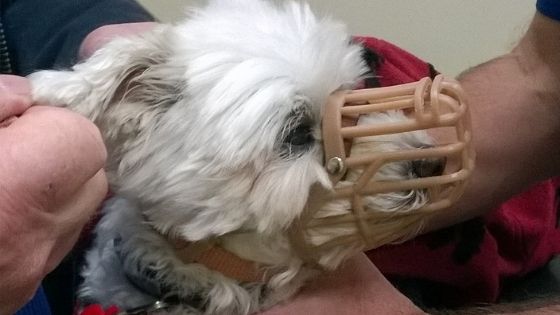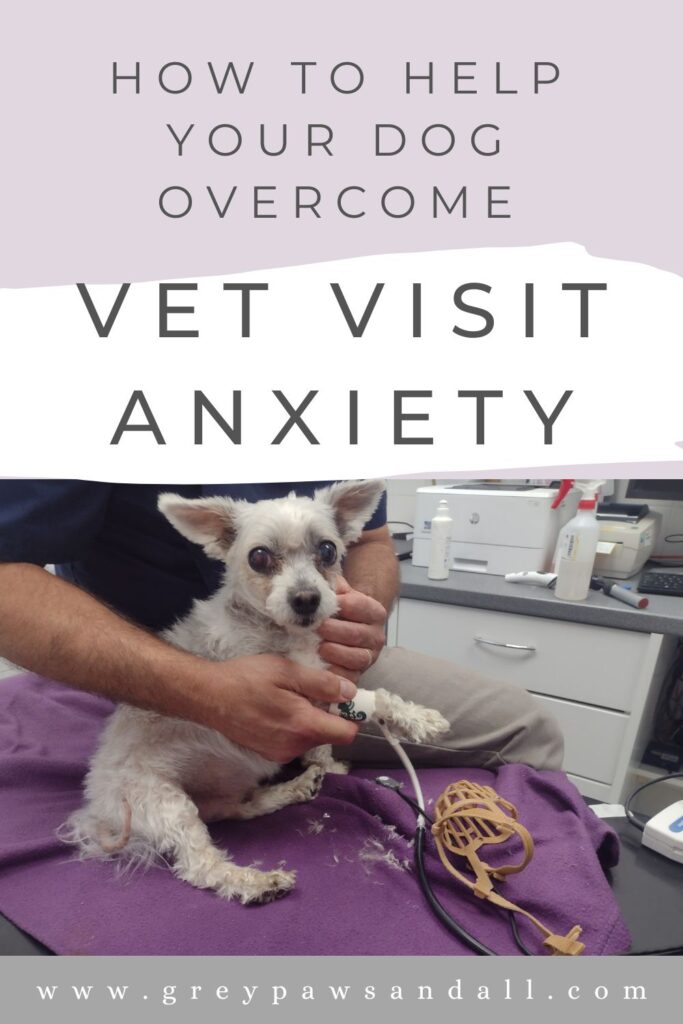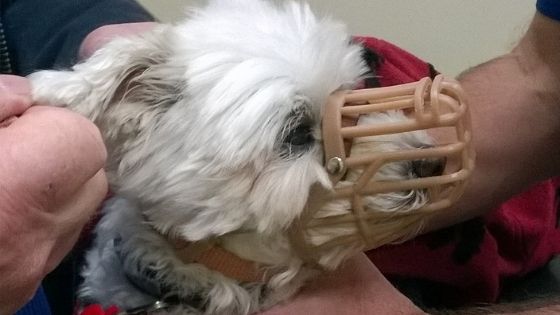What do you do when your dog hates the vet, but a health condition makes frequent appointments necessary?
To help reduce anxiety drive to the vet, park far enough away so your dog doesn’t react, give her treats and drive home. Try that a few times. If that went well, next step is walk her by the vet, again at a distance she’s comfortable and more treats. There are more steps to follow, but these desensitization and counter-conditioning exercises can reduce your dog’s anxiety level.
What Do Desensitization and Counter-Conditioning Mean?
Desensitization
Desensitization means gradually exposing your dog to a situation, person or thing (stimulus) that brings on the undesirable behavior. Over time, you should see less reaction and an ability to better tolerate what he used to fear.
Counter-conditioning
Counter-conditioning means changing your dog’s response to that stimulus. This is accomplished by pairing what he reacts to with a favorite reward such as a treat, attention or toy.
Why Dogs Hate the Vet?
We often use the word hate, but we typically mean fear or anxiety. Aggression is one way it can manifest.
Who can blame them! A vet visit can be pretty traumatizing for many dogs, even the sweetest-natured and easy going can become anxious.
Depending on the time of day you go, and popularity of your vet’s practice, walking through the door can be a trauma all its own. A room full of strange people and unfamiliar dogs. Some may be barking or at least showing some level of anxiety. What about cats in crates? Your dog may already fear cats, or never having encountered them before it’s another new experience on top of all the other sensory overload. It’s no wonder your dog is heading for the exit!
They walk into a room with new smells and sounds, dogs are barking, they’re brought into a room, put on a cold examination table and poked and prodded. Sometimes they have a needle stuck into them which can be a bit painful, or a finger shoved up you know where! Sorry for that last graphic, but it’s true. If your dog is sick or hurt, he’s already feeling bad and then he has the rest to deal with.
It’s no wonder dogs develop anxiety about going to the vet.
How to Reduce Your Dog’s Anxiety During Vet Visits
The recommendations listed below are in no particular order. Since I don’t know your dog’s anxiety level, I have included a variety of options to help even the most severe cases.
If your dog is so terrified she starts to panic when she realises where she’s going, be sure to read through to the end, because I have included a step by step guide to help this level of anxiety.
NOTE: Depending on anxiety levels and triggers, not all options will be a viable starting point for every dog.
Before we begin I wanted to mention something. Is it possible all this anxiety is because your dog doesn’t like the vet? Maybe he’s been rough with him in the past or he senses something he doesn’t like. Whatever the reason, have a read through this article I wrote called “8 Things to Think About When Choosing a Vet.”

Pay Your Vet a Social Visit
Visit your vet’s office when you don’t have an appointment. Arrange this ahead of time, so a staff member will be free to join in this exercise. Have him or her make a fuss, and give your dog a favorite treat. Don’t stay long, a minute or two then leave.
Get Your Dog Used to Being Handled
Petting your dog is not the same as how hands on your vet is during an examination. Why not try and mimic at least some of what goes on, in your own home? Hold his paw, look in his ears, open his mouth and snuggle him close to you as though lightly restraining him.
Keep each of these practice sessions very short, and repeat every day.
Play Calming Music
Play calming music at home that relaxes her, then play the same at the vet. You can do this during a scheduled appointment, or a social visit as mentioned above. Type “dog calming music” into Youtube for a wide variety of options. It can also help if your dog has generalized anxiety.
Make the Setting More Comfortable
Exam tables are very slippery and cold, and doesn’t help an anxious dog to be sliding all over the place. Bring a spongy non slip mat with you for comfort.
Entertain/Distract Her While Waiting
Feeding favorite treats or playing with a toy together may distract her.
Socialize Your Dog
Is the vet the only thing your dog is anxious about, or is he fearful around other people or in various situations as well?
If he fears more than the vet, it’s possible your dog wasn’t well socialized so now is a good time to start.
Why is it so important? It will help him deal with the challenges that come with living in a human world, and allow him to gain confidence.
Ideally one starts when they bring their puppy home, but if you adopted an older dog, it’s never too late to start.
Who and What to Expose Him To
The list is pretty much endless but here’s a start:
- Men
- Women
- Babies
- Mailman
- People in wheelchairs
- Bicycles
- Strollers
- Skateboards
- Cats
- Car rides
- Walking on different surfaces such as wood, sand, tile, carpet
- Vacuum cleaner (off, then when it’s on)
…and anything else you can think of!
Where to Socialize Your Dog
On daily walks: On your daily walks you’ll have lots of opportunities, but don’t overwhelm him. Start off in quieter areas with very little traffic, gradually working up to different times of day with more cars, more people and more experiences.
Sit at an outdoor café together, take him into a dog friendly store, visit a dog park but again, everything slowly in short blocks of time.
In the house: One example – leave the vacuum cleaner out for him to sniff. If he’s okay, turn it on in a room away from where he is so he hears it but not too loudly. Is he okay? Use it closer and closer to where he is, until he ignores you when in the same room. My dog used to be terrified of the vacuum, he would run when he saw it come out. Now I can literally do it right near him and he’s fine.
Another example – invite adults, kids, even other dogs to visit from time to time so he gets used to seeing them in his home. Not all at once though!
Puppy socialization classes: For the senior dog owners that also have a puppy, I recommend joining a puppy socialization class. Trainers and vets offices both typically have them, ask to observe one before you commit.
Visit people in their homes: Simply going into a new environment is a great learning experience.
Keep each experience positive and short.
Natural Remedies
Consider trying natural remedies, in conjunction with training techniques mentioned in this post.
Please read this ⇒ “22 Natural Ways to Calm Your Anxious Dog”
Medication
Speak to your veterinarian about a low dose medication to take the edge off. A combination of training and natural options may mean this is only temporary, but you’ll discuss that with your vet.
Use a Muzzle

If your dog’s anxiety is so strong he exhibits aggressive behavior, a muzzle is best for everyone’s safety. When we first adopted Jack, he had severe anxiety about everything, so vet visits were a nightmare. For everyone’s safety we used a muzzle. He no longer needs one, but it was the right decision at the time.
This is a picture of Jack, and how vet visits used to be.
Easy to follow steps to get your dog used to the muzzle
Depending on how your dog reacts, you may be able to skip ahead.
Step One
Put the muzzle on the floor, let your dog sniff around it and give him a treat.
Step Two
Pick the muzzle up, show it to him close up, give him a treat
Step Three
Drape it over your dog’s head, remove it right away then treat
Step Four
Drape it over his nose, remove it immediately then treat
Step Five
Put the muzzle on, hold it in place, remove then treat
Step Six
Put the muzzle on using the clasp, remove then treat
Step Seven
Keep the muzzle on several seconds, remove then treat
Gradually work up to him wearing it 10 minutes or so.
NOTE: Anxious dogs won’t always take treats, but see if he’ll take a treat during the step instead of after.
Visit a Fear Free Veterinarian
This initiative was started by Dr Marty Becker with a mission “to prevent and alleviate fear, anxiety, and stress in pets by inspiring and educating the people who care for them.”
For more information and to find a “fear free” professional near you, visit their website.
Home Visits
It could be the environment that scares your dog, not the vet. What about booking a home visit and see how that goes?

Step by Step for Dogs That Are Really Terrified of the Vet…Before They Even Get There!!
• This section is for anyone who has a dog that starts getting anxious the second they realise where they’re going, more specifically once they’ve reached the parking lot. My dog starts before that!
• I know this looks like a very long process, and it might be, but doing it gradually increases the likelihood of success.
• These are practice sessions, not to be done for actual appointments
• It’s possible you may be able to skip over a few steps, but I suggest you start from the beginning and see how it goes.
NOTE: Practice each step a few times, and over the course of a few days if needed. Only move on to the next step if your dog is calm. If at any point he seems nervous, you’ve likely moved too quickly. Go back to the step where he was still relaxed, and go slower next time.
Step One
If you normally pass right by the vet when entering the parking lot, use another entrance if there is one. Park far enough away so your dog doesn’t react, sit in the car for a couple of minutes, give him some treats then go home. Over time you’ll want to park closer and closer.
Step Two
Parking further away as in step one, take your dog for a walk in the area. Make sure you’re far enough away so he doesn’t notice, treats then home. Over time you’ll want to walk closer to the office.
Step Three
Walk into the office, staying close to the door, right back out and treat. Over time you’ll want to stay in the spot longer. When you’re there longer than a second or two, try giving him the treat inside rather than waiting until you leave.
Step Four
Walk further into the office, treat and walk right back out. Over time practice staying longer, and giving him treats while inside.
Step Five
Have your dog step on the scale, treat then right back off.
Step Six
Sit in the waiting room for a second, get up and leave, treat.
…and so on.
If your dog is afraid to go to the vet, what tips have you found to make those visits easier? Sharing helps others so please leave your advice in the comments section below.
I help senior dog parents struggling with anticipatory grief and quality of life issues by offering practical tips, advice and one on one support. I am also a Certified Pet Loss Grief Support Coach, helping you navigate through your pet loss journey.
Visit my services page to book a FREE 20 minute discovery call, or email me (Hindy) at hpearson141@gmail.com if you have any questions.
I’ve been rescuing and caring for senior dogs since 2009. From vision and hearing loss to obesity, dementia, kidney disease, liver issues, cardiac problems, Cushing’s, mobility challenges and more, you could say I’ve dealt with and learned a lot! In addition to my hands on experience, I’ve taken many courses and earned several qualifications to keep learning how to help senior dogs and they include: Senior Dog Enrichment, Understanding Canine Anxiety, Care of the Senior Pet and I’m a Certified Pet Loss Specialist.

